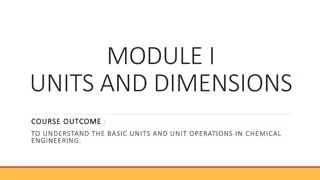Understanding Separation Columns in Chemical Engineering
Explore the world of separation columns including distillation, absorption, and extraction, along with empirical correlations, minimum number of stages, Fenske equation, Underwood equation, Kirkbride equation, examples, and solutions presented by Dr. Kh. Nasrifar from the Department of Chemical and Petrochemical Engineering. Dive into the complexities of multicomponent distillation and discover the calculations involved in determining the number of stages and minimum reflux ratio.
Download Presentation

Please find below an Image/Link to download the presentation.
The content on the website is provided AS IS for your information and personal use only. It may not be sold, licensed, or shared on other websites without obtaining consent from the author. Download presentation by click this link. If you encounter any issues during the download, it is possible that the publisher has removed the file from their server.
E N D
Presentation Transcript
SEPARATION COLUMNS (DISTILLATION, ABSORPTION AND EXTRACTION) Dr. Kh. Nasrifar Department of Chemical and Petrochemical Engineering
MULTICOMPONENT DISTILLATION: Empirical Correlations The Erbar-Maddox correlation is given in this section, as it is now generally considered to give more reliable predictions. Their correlation is shown in Figure 11.11; which gives the ratio of number of stages required to the number at total reflux, as a function of the reflux ratio, with the minimum reflux ratio as a parameter. To use Figure 11.11, estimates of the number of stages at total reflux and the minimum reflux ratio are needed.
Minimum number of stages (Fenske equation)
Fenske equation In terms of light key and heavy key components, the previous equation can be written as where LK is the average relative volatility of the light key with respect to the heavy key, and xLK and xHK are the light and heavy key concentrations. The relative volatility is taken as the geometric mean of the values at the column top and bottom temperatures. To calculate these temperatures initial estimates of the compositions must be made, so the calculation of the minimum number of stages by the Fenske equation is a trial and-error procedure.
Minimum reflux ratio: Underwood equation The underwood equation is used for estimating minimum reflux ratio:
Underwood Equation Where is the root of the following equation
Feed-point location Kirkbride equation
Example (Erbar-Maddox method) Estimate number of stages by changing reflux ratio.
Example: Estimate the position of the feed point for the separation considered in the previous Example for a reflux ratio of 3.























